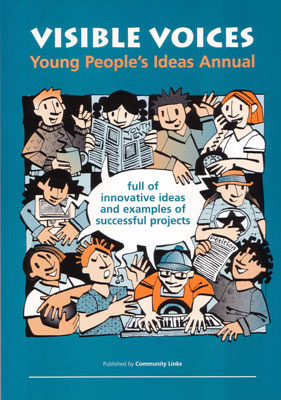2 Understanding communication
What is happening when you try to communicate with someone? Figure 2 is an example of a publication by Community Links, a social action charity rooted in east London and nationally focused. It is the front cover of Visible Voices, a collection of projects run by and for young people around the United Kingdom (UK). It is one of a number of ‘Ideas Annuals’ published by Community Links in order to share good practice and inspiration among voluntary organisations.
Activity 2 Conveying a message
Look at Figure 2 carefully and then try to answer the following questions.
Who do you think is intended to see this?
What other groups of people are likely to see it?
What message do you receive from it?
Do you think it is the message that the writer intended?
Comment
Visible Voices is a publication intended for young people involved in community development, but it will also be seen by:
- members of the general public
- people in the media
- people working for companies or trusts that might fund some of the activities
- policy makers in government and elsewhere.
Here are some possible reactions to it:
- ‘cheap and cheerful’
- rather messy and amateurish
- confusing
- fun
- happy
- political correctness
- a rose-tinted view of multicultural community action.
It is possible that the primary audience will find this rather informal style less intimidating than a more ‘professional’ looking document. However, the danger is that others might think the content will be amateurish, messy or, perhaps, too good to be true. In fact, the document is full of useful ideas, has a good contents page and is attractively laid out.
In the real world, it is rare for someone to do what you have just been doing in this task – to concentrate solely on a ‘communication’ for several minutes and analyse it in the way you have done. Most of the time, people are receiving messages with minimal interest or concentration. Because of this lack of concentration, many of the messages we receive are lost, misunderstood or garbled.
Even when you are talking to someone you know, face to face, you cannot be sure they are taking in all you say or understanding it in the same way you do. If you are communicating at one remove, perhaps by email, through a website or in a report, you have less chance to check what someone else is taking in, and so the chances of misunderstandings going undetected are higher.
These examples show that communication is not a straightforward process. Sending a message is not a guarantee that it will be received or, that if it is received, it will be understood in the way that you intended.

